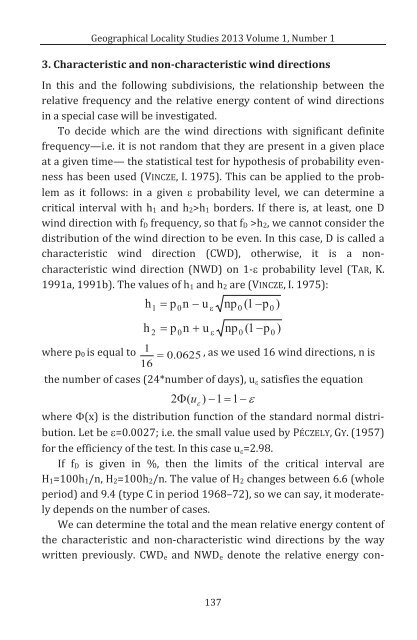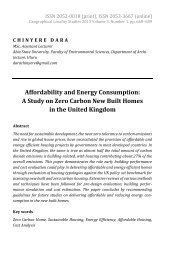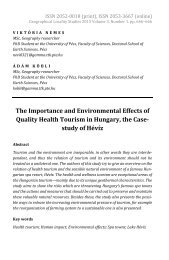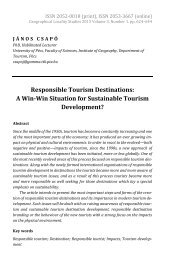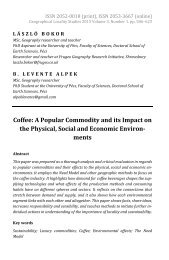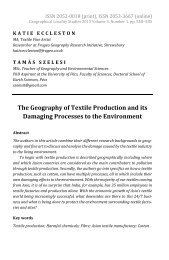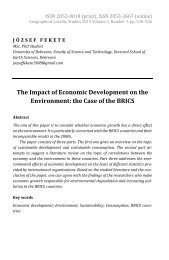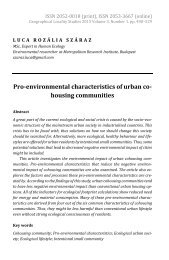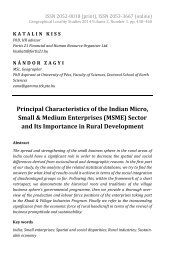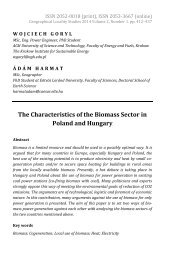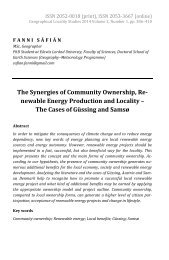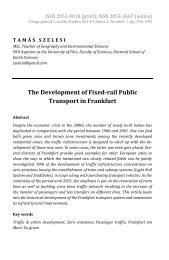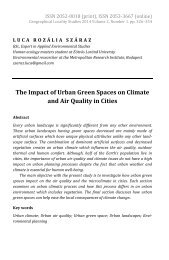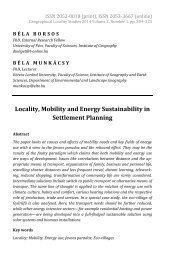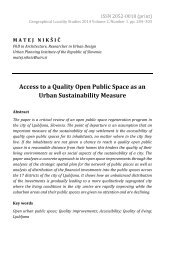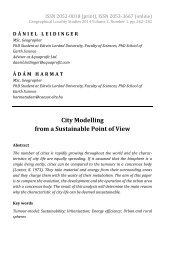Károly Tar: Energetic Parameters of the Wind Directions
The objective of this study is to assess whether changes in the surface pressure field over Europe are reflected in the statistical structure and the inner definiteness of the wind energy (relative frequency, relative energy content, mean velocity, etc.) field over Hungary, despite the country’s specific pressure field.
The objective of this study is to assess whether changes in the surface pressure field over Europe are reflected in the statistical structure and the inner definiteness of the wind energy (relative frequency, relative energy content, mean velocity, etc.) field over Hungary, despite the country’s specific pressure field.
Create successful ePaper yourself
Turn your PDF publications into a flip-book with our unique Google optimized e-Paper software.
Geographical Locality Studies 2013 Volume 1, Number 1<br />
3. Characteristic and non-characteristic wind directions<br />
In this and <strong>the</strong> following subdivisions, <strong>the</strong> relationship between <strong>the</strong><br />
relative frequency and <strong>the</strong> relative energy content <strong>of</strong> wind directions<br />
in a special case will be investigated.<br />
To decide which are <strong>the</strong> wind directions with significant definite<br />
frequency—i.e. it is not random that <strong>the</strong>y are present in a given place<br />
at a given time— <strong>the</strong> statistical test for hypo<strong>the</strong>sis <strong>of</strong> probability evenness<br />
has been used (VINCZE, I. 1975). This can be applied to <strong>the</strong> problem<br />
as it follows: in a given probability level, we can determine a<br />
critical interval with h 1 and h 2 >h 1 borders. If <strong>the</strong>re is, at least, one D<br />
wind direction with f D frequency, so that f D >h 2 , we cannot consider <strong>the</strong><br />
distribution <strong>of</strong> <strong>the</strong> wind direction to be even. In this case, D is called a<br />
characteristic wind direction (CWD), o<strong>the</strong>rwise, it is a noncharacteristic<br />
wind direction (NWD) on 1- probability level (TAR, K.<br />
1991a, 1991b). The values <strong>of</strong> h 1 and h 2 are (VINCZE, I. 1975):<br />
h1 p0nu<br />
np0(1p0)<br />
h2 p0nu<br />
np0(1p0)<br />
where p 0 is equal to 1 0. 0625 , as we used 16 wind directions, n is<br />
16<br />
<strong>the</strong> number <strong>of</strong> cases (24*number <strong>of</strong> days), u satisfies <strong>the</strong> equation<br />
2(<br />
u)<br />
11<br />
where (x) is <strong>the</strong> distribution function <strong>of</strong> <strong>the</strong> standard normal distribution.<br />
Let be PÉCZELY, GY. (1957)<br />
for <strong>the</strong> efficiency <strong>of</strong> <strong>the</strong> test. In this case u <br />
If f D is given in %, <strong>the</strong>n <strong>the</strong> limits <strong>of</strong> <strong>the</strong> critical interval are<br />
H 1 1 /n, H 2 2 /n. The value <strong>of</strong> H 2 changes between 6.6 (whole<br />
period) and 9.4 (type C in period 1968–72), so we can say, it moderately<br />
depends on <strong>the</strong> number <strong>of</strong> cases.<br />
We can determine <strong>the</strong> total and <strong>the</strong> mean relative energy content <strong>of</strong><br />
<strong>the</strong> characteristic and non-characteristic wind directions by <strong>the</strong> way<br />
written previously. CWD e and NWD e denote <strong>the</strong> relative energy con-<br />
137


